Benjamin Sobieck's Blog, page 16
March 23, 2015
On Writing Guns - Should Characters "Dig Out" Bullet Injuries?
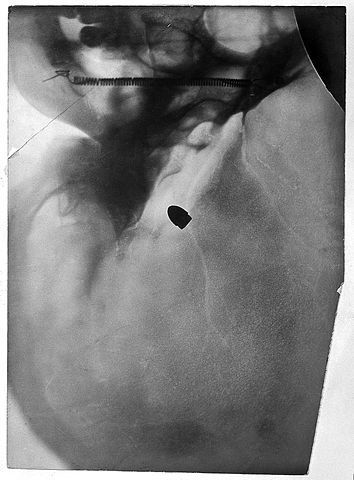
TLDR: No.
Not having been shot by a gun (thankfully), I’m a little naive in the department of gunshot injuries. However, a Facebook conversation the other day brought up the topic of characters treating gunshot wounds. Books, movies and TV shows will often depict a character “digging out the bullet” before wrapping up the wound.
This makes for great thematics, but I always doubted the practicality of digging out the bullet first. It turns out I’m right (self-high five), according to one of my favorite sources for ditch medicine, the Living Ready Pocket Manual: First Aid (disclaimer: we publish this at my work, and you should go buy it right now).
The author, Dr. James Hubbard, MD, recommends forgetting about the bullet until the wounded person (or character, in this case) can get to a hospital for proper assessment and treatment. Instead, focus on stopping the bleeding (apply pressure/coagulant), treating the wounded for shock (keep warm with blankets) and monitoring symptoms for relaying to a real doctor.
Hubbard has this to say about “digging out the bullet” ahead of real medical treatment:
In most circumstances, you don’t want to remove an implanted bullet. It’s almost impossible to find, and it may actually be corking up a big blood vessel.
Thousands of military members live with shrapnel in their bodies every day. Unless there’s initial infection from the wound itself, the body adapts to most metal without much serious problem.
The exact thing happened to Dick Moonlight, novelist Vincent Zandri's PI character. A shard of bullet left over from a botched suicide attempt remained in the titular character's head, causing him to black out at inconvenient moments. It's suggested the doctors can't remove the shard without killing him. Moonlight may be a work of fiction, but that's pretty close to reality.
If you enjoyed this post, remember to sign up for my free e-newsletter. You’ll also want to pre-order my book from Writer’s Digest about writing guns and knives in fiction. And if you’re wishing there were one more way to give me your money, you can pre-order my new crime novel, Glass Eye, here.
March 2, 2015
An E-Book Cover Designer Doing It Right

Ladies and gentlemen, I present to you Paper & Sage, which I consider to be the best e-book cover designing service I've encountered. I liked it so much that I put down my own money to get a cover created. I can't reveal the cover just quite yet (it's for a secret project), but you can take my word that the final product was up to snuff. The cover wouldn't look out of place next to anything you'd find in a bookstore.
When I went hunting for e-book cover designers, I found most sites fall into one of two categories. Either they offered inexpensive pre-made covers that looked just as cheap, or they offered a full service designer way out of my regular-person-living-in-the-real-world budget.
Paper & Sage is a little different. You choose from pre-made covers at a reasonable price, then hand the reins over to a designer who will make tweaks according to your specifications (colors, verbiage, fonts). If you need several big changes, Paper & Sage offers a custom package for a higher price.
This arrangement means you can get the benefits of a one-on-one designer experience at the cost of a pre-made cover service. Even better, once a cover is sold, it won't be offered again.
Paper & Sage didn't prod me to write this review. I did it on my own because the people doing things right deserve to be recognized. And Paper & Sage is definitely worth your dollars.
February 24, 2015
On Writing Guns - How Loud is a Silencer?
Building on this post debunking pillows used as silencers, here's a handy chart detailing the noise levels of silenced (aka "suppressed") firearms. This is excerpted from an infographic from Silencerco.
The takeaway: silencers/suppressors aren't as convenient as fiction would like to think. Get creative in those stealthy scenes. What other ways are there to be silent but deadly? (er, wait...)
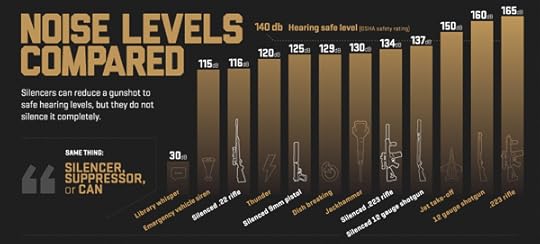
If you're having a hard time reading that chart, here's the breakdown (in decibels).
Library whisper - 30 dbEmergency vehicle siren - 115 dbSilenced .22 rifle - 116 dbThunder - 120 dbSilenced 9mm pistol - 125 dbDish breaking - 129 dbJackhammer - 130 dbSilenced .223 rifle - 134 dbSilenced 12 gauge shotgun - 137 dbJet taking off - 150 dbNon-silenced 12 gauge shotgun - 160 dbNon-silenced .223 rifle - 165 db
February 22, 2015
On Writing Knives - What are Those Wavy Things on the Blade?
When researching knives for a story, you may come across wavy patterns on the blade that look like this:
[image error]
Without getting too technical, those waves are created by layering the steel used to make the blade. The result is called "damascus" steel. A wave pattern is just one of the shapes found in damascus steel. The smith can create any number of wacky designs, from hearts, stars and horseshoes to clovers and blue moons. Er, wait, that's the jingle for Lucky Charms. But the point is still the same.
Some say damascus steel is stronger or longer lasting than "regular" steel. I'd say there are too many variables to make that judgement call. It's strictly a design element that looks cool and adds a nice touch to a knife. Here's an example from one of my own knives.
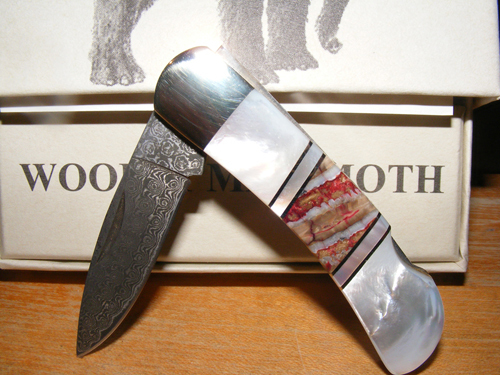
In this case, the damascus steel has a "raindrop" pattern instead of wavy lines like in the example above. It's still damascus either way.
When writing, the only time I imagine you'd reference damascus is to look in-the-know about knives, which is fine by me. Because damascus is pricey and most often used for aesthetics, I wouldn't depict it on knives designed for hard use.
Pre-order my book, Weapons for Writers: A Practical Reference for Writing Firearms and Knives in Fiction, from Amazon.
February 21, 2015
On Writing Guns - How a 1911 Pistol Works
Chances are good that if your stories feature a lot of pistol play, one of those handguns is a .45 caliber Colt 1911. This type of handgun's been around for more than 100 years, and is just as popular today as back then. You'll instantly recognize it from countless TV shows, movies and references in books. Usually, when writers reference a ".45," they mean it's a .45 caliber 1911. Unless it's a western, in which case they'd likely be talking about the iconic Colt Single Action Army revolver. But that's for another post.
The website Animagraffs features super cool GIFs of how a 1911 works. Here's the main one. The rest, showing close-ups of certain mechanics, are here. Be sure to check them out. The person behind this GIF will even make one for you, from speakers to spiders (for a price, of course).
[image error]
The takeaway for writing fiction might not be apparent just by looking at this GIF. But look a little closer, and you'll see that the slide on top is back and the barrel is exposed once the ammunition runs out. The hammer is automatically cocked as the slide moves back between shots (it resets into a forward position in the animation, but that'd have to be done manually). You can also see not one but two safeties: the thumb safety and the grip safety. Both would need to be disengaged before firing. Details like that can add a nice touch to a passage featuring a 1911.
* Thanks to crime writer Court Merrigan for the tip about this GIF. Check out his books on Amazon.
February 20, 2015
What a Handgun Says About the Character Using It
This guest post comes from Travis Pike. He's a Marine veteran, a firearm instructor and a writer. The post that follows pokes a little fun at stereotypes in the gun world, but I think his satire can apply to assigning handguns to characters, too. Have fun with it!
~Ben
1. The Revolver
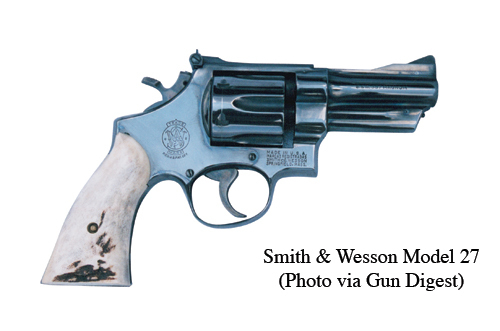
You’re a hipster.
By this point in time the old revolver guys are out of their prime, hardly gun slingers anymore. These days those men and ladies packing revolvers do it because of a sense of nostalgia and the cool factor associated with the sixgun. There’s nothing wrong with that, and it’s hard to beat the cool factor of a Smith & Wesson 686. Who really needs more than six rounds? Revolvers don’t jam, and you don’t even really have to know what timing is. Plus, there are polymer revolvers that are totally retro new school.
2. The Steel Frame Semi-Automatics (the Beretta 92 and Smith & Wesson 3rd Generation pistols)
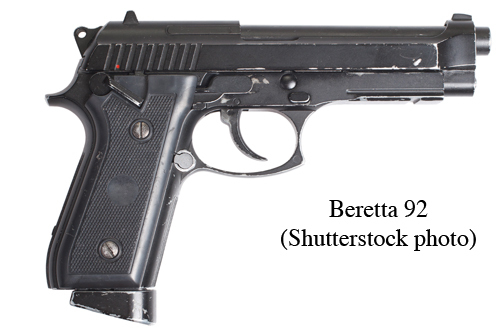
You’re the new old school.
Sure, revolvers are stereotypically for the old school guys, but that ship has sailed. These days the old school guys grew up with big, heavy, steel frame semi-automatics. The beat cop 30 years ago wasn’t carrying the Smith & Wesson Model 10 or the Colt Python revolvers, no sir. You carried your boat anchor with pride, always knowing if you ran out of ammo you could beat someone with it. You were part of the wondernine generation and still don't understand why tupperware is part of a gun.
3. The 1911
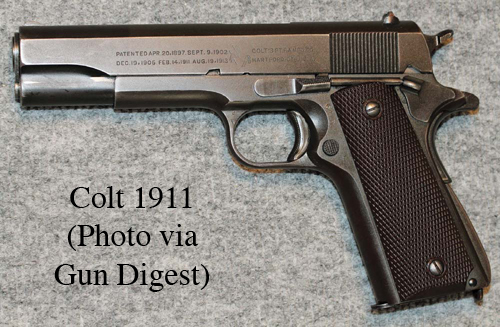
You’re a cultist.
Owners of 1911s used to fall into a few different groups, from the old school military guys, to those with modern tastes in a classic weapon. All these groups have merged to build the 1911 supercult. As a 1911 user you believe there is no better gun, and gun design pretty much quit after John Browning delivered this weapon from heaven. You don’t need more than eight rounds, you don’t need no stinkin’ polymer, and you sure as hell don’t mind spending a few grand on a premium 100-year-old design. Also, who cares if your gun is mag picky.
These 1911 guys and gals spend time to perfect their own skills to fill the inadequacies of the century-old design. A 1911 user isn’t just a 1911 owner. They are a complete cult, dedicated to the one true gun.
4. Glock
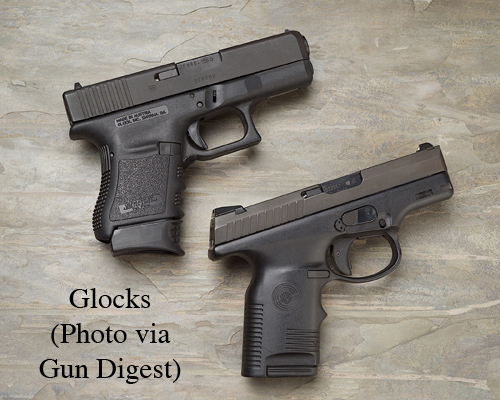
You drive a Honda Civic with a wing.
Everyone says get a Glock, so you did. It works every time you pull its plastic trigger. You don’t care if the trigger is sub standard, the grip is like a 2x4 piece of lumber, and the gun is about as attractive as the Elephant Man. You spend a little and replace the trigger, then a little bit more so you can replace the sights. After that you can get the grip stippled, and then maybe all titanium internals. You can keep spending money until your Civic, err, Glock, is a real gun.
Glock guys tend to understand their weapon is utilitarian, but can’t seem to accept it’s good enough as is and try to spend money to fill their ‘perceived’ problems with it.
5. H&K or SIGs

You think you can buy shooting skills.
As you lovingly finished your newest Soldier of Fortune magazine, you hold your SIG P226 in your hand and think of how it could have killed Osama. When you pick your H&K you’re not just picking up a gun, you're picking up a piece of art. With these guns you don’t need time at the range. In fact, they pretty much shoot themselves for you. The handcrafted German/Swiss engineering has resulted in a level of perfection no one but Zeus himself has touched, and you have it in your hands. Customer support means little to you, as does your children’s college funds. Who needs college when you have a SIG X5?
February 19, 2015
Crime Writer Uses Gun Digest Book for Research
Wellsir, I was encouraged to see a fantastic wordsmith of crime fiction and comic book writer, Duane Swierczynski, post on Facebook the other day about using a book we publish at Gun Digest for research. It made me happy to see this not only because I work for Gun Digest, but also that there's an appetite out there for this type of information.
Here's the book author Swierczynski picked up:
And here's the best place to pick up said book, direct from the publisher. The level of technical detail in Gun Digest books might not be useful for writers with a casual interest in firearms. But if you're looking for the nitty gritty, they're a better source of information than a lot of what's available online.
Or you could always wait for Weapons for Writers to drop this July. (wink, wink)
February 17, 2015
On Writing Guns - Using a Pillow as a Silencer
I’ve gone into the myths surrounding silencers (aka suppressors) on firearms before. These devices usually receive some goosing up in the physics department when they’re used in fiction. But what about the old pillow-as-silencer trope? Is there any truth to that?
Short answer: no. Pillows do a bad job of containing the explosive gases released by a gunshot. Hell, they can barely contain snoring.
Here’s an excellent video demonstrating this with live ammo, different types of pillows and a decibel meter.
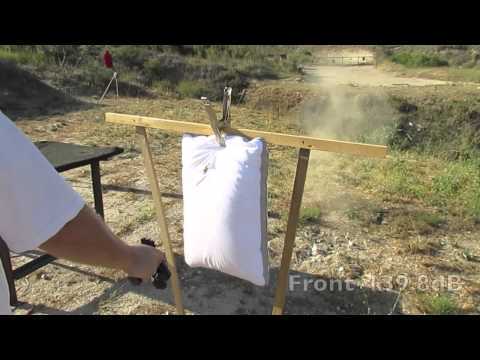
Also, despite what the movie Postal might suggest, cats don't make for effective silencers/suppressors, either. Not even the fluffy ones.

Pre-order my book, Weapons for Writers, to be published by Writer's Digest in July, from Amazon.
February 13, 2015
On Writing Knives - Guide to Knife Anatomy
These excellent illustrations and descriptions come from BladeHQ.
Anatomy of an Automatic Knife
Automatic knives are designed primarily for Military, Police and EMT duty, these knives are simple to open in an emergency. This is done by pushing a firing button or pulling a lever. Check the laws in your area before purchasing an automatic knife, as they are restricted in many areas.
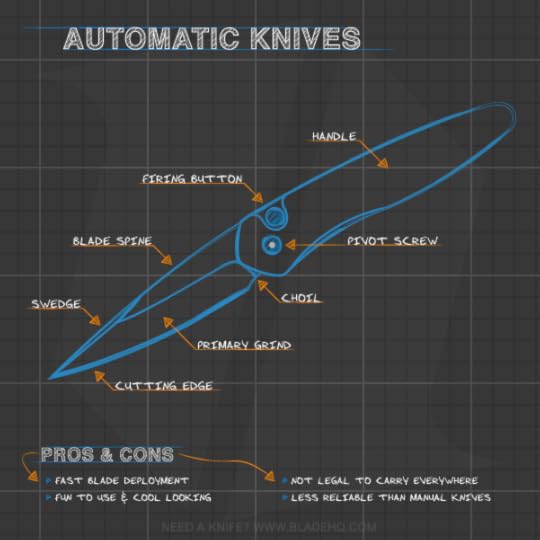 An infographic by the team at Blade HQ
An infographic by the team at Blade HQ
Anatomy of a Manual / Spring Assisted Folding Knife
Manual knives are legal in most areas, which means they are extremely common. Often, this type of knife is also recognized as a “pocket knife.” Spring assisted knives are roughly the same as manual knives, but they have a spring inside the handle that helps deploy the blade much faster. Spring assisted knives typically have a thumb stud and/or flipper.
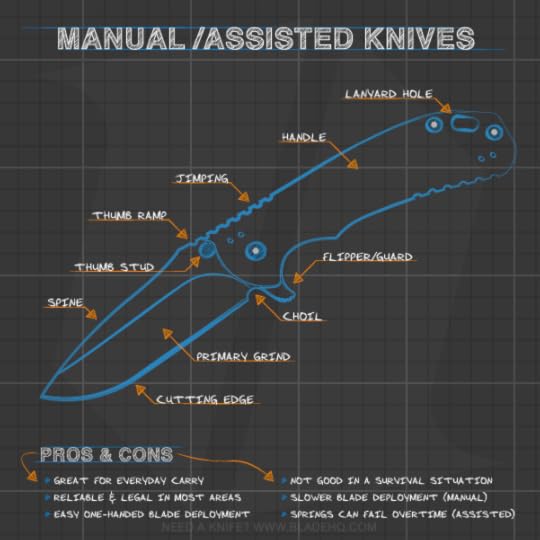 An infographic by the team at Blade HQ
An infographic by the team at Blade HQ
Anatomy of a Fixed Blade Knife
Fixed blade knives don’t fold or contract, like other types of knives. Fixed blades are perfect for nearly any use—they are carried by sportsmen, hunters, campers, and more.
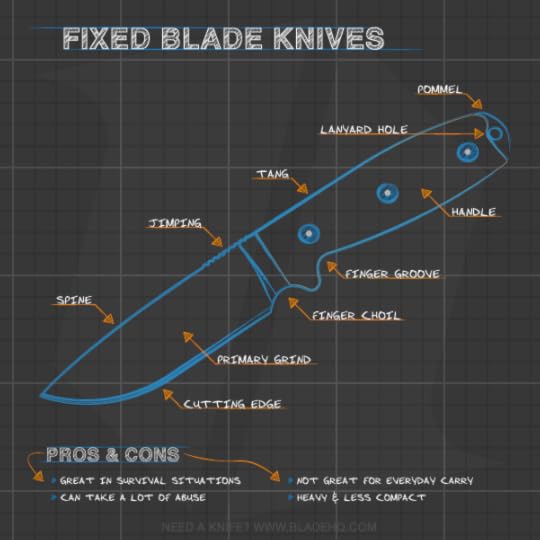 An infographic by the team at Blade HQ
An infographic by the team at Blade HQ
Anatomy of an Out The Front Knife
Out The Front knives are similar to automatic knives in many ways; they are opened by pushing a thumb slide or pulling a lever, but with an OTF knife the blade always deploys out the front of the handle—not the side, like automatic knives. OTF knives are restricted in many areas so be certain to consult your local laws before purchasing these items.
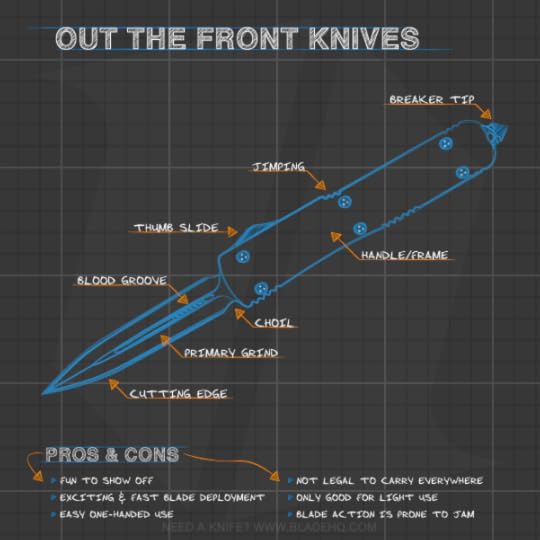 An infographic by the team at Blade HQ
An infographic by the team at Blade HQ
Anatomy of a Butterfly Knife
Some people spend years trying to master the skill of flipping butterfly knives, A.K.A. balisong knives. It’s debatable whether it’s more fun to flip a butterfly knife or to watch someone flip— it looks really cool, and it’s practically mesmerizing.
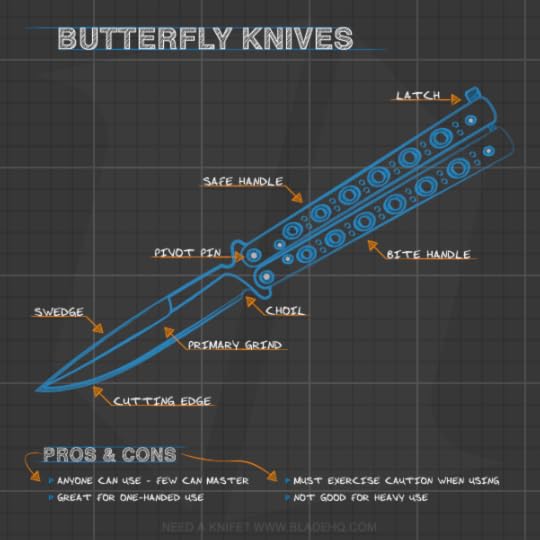 An infographic by the team at Blade HQ
An infographic by the team at Blade HQ
If you found this post helpful, be sure to sign up for my free e-newsletter, full of exclusives I don't offer anywhere else. Don't forget to pre-order my upcoming book from Writer's Digest, Weapons for Writers: A Practical Reference for Writing Firearms and Knives in Fiction.
On Writing Knives - Guide to Blade Styles
When it comes to knives, not all blades are created the same. Designs usually have a purpose in mind, running the gamut from fruit sampling to fighting. When writing about a knife in use, it could be helpful to describe the type of blade being used. These handy little illustrations, excerpted with permission from American Premium Guide to Knives & Razors, can help point you in the right direction. This isn't comprehensive, but it should get you started.
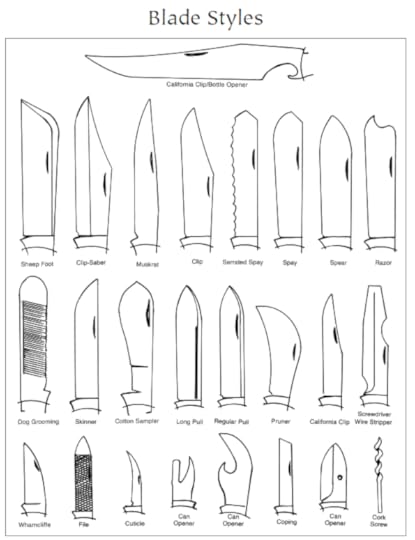
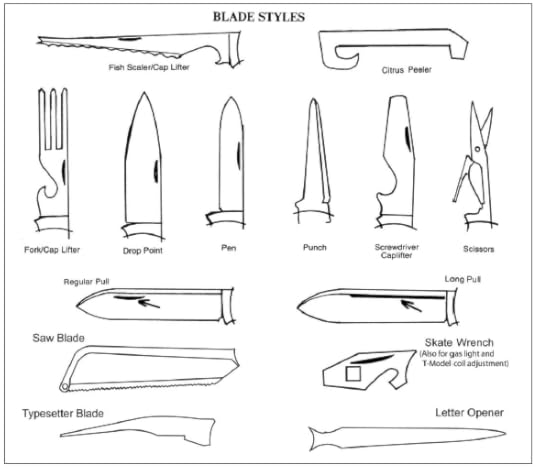
Here are some more from USA Knife Shop.
Here are more from BladeHQ.com.
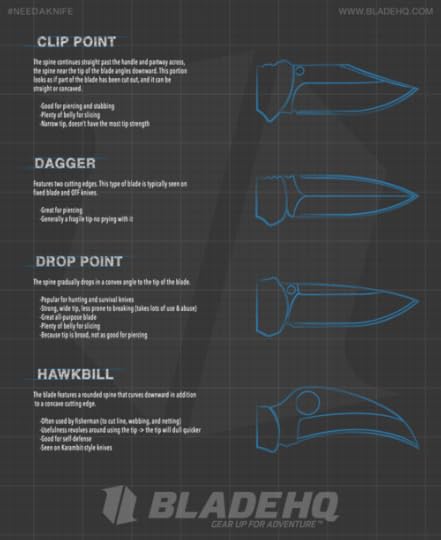
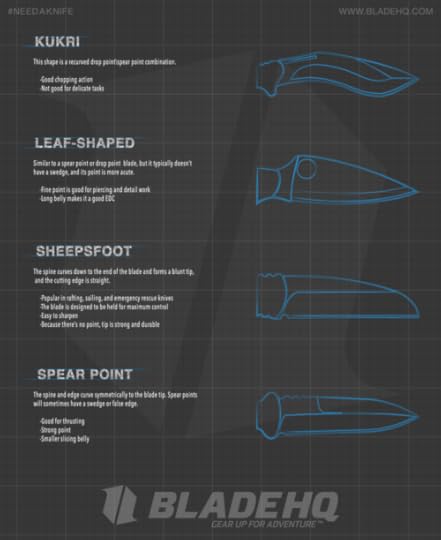
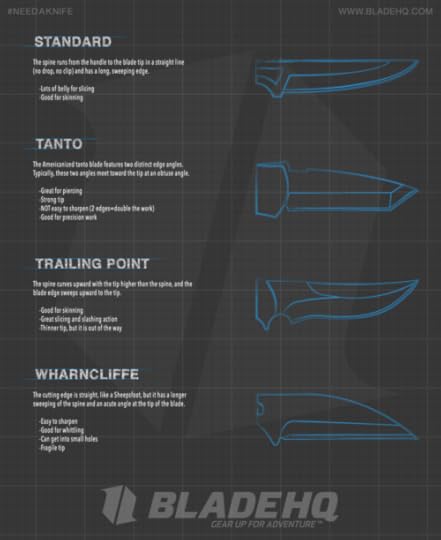
If you found this post helpful, be sure to sign up for my free e-newsletter. My book, Weapons for Writers: A Practical Referencing for Writing Firearms and Knives in Fiction, will be published by Writer's Digest in July 2015. Pre-order it from Amazon here.





